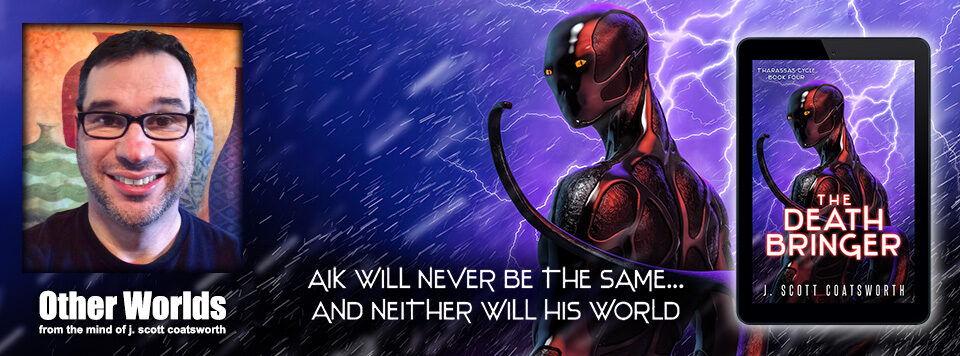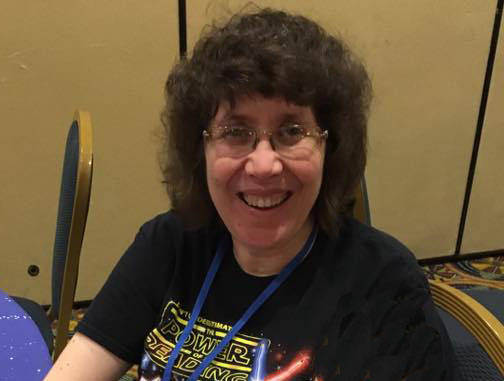Welcome to my weekly Author Spotlight. I’ve asked a bunch of my author friends to answer a set of interview questions, and to share their latest work.
Today, Laura Frankos has written mysteries, fantasy and science fiction stories. She has published one mystery novel, Saint Oswald’s Niche, which is currently out of print, a time travel novel, Broadway Revival, and The Broadway Musical Quiz Book. Frankos also writes the Broadway history column “The Great White Wayback Machine” and has published numerous trivia quizzes about Broadway plays.
Thanks so much, Laura, for joining me!
J. Scott Coatsworth: What’s the weirdest thing you’ve ever done in the name of research?
Laura Frankos: I’ve ordered Bronx cocktails at bars and restaurants across the nation! These days, if you order a Bronx cocktail, the waiter says, “A what?” and has to Google it. But it was one of the most popular drinks of the 1930s, before losing its position to the martini. (Gin, sweet vermouth, dry vermouth, orange juice.) Since my time traveler jumps from 2079 to 1934, I had a blast researching 1930s menus for his consumption. There’s a Broadway musical connection to this drink, too: a prim aunt drinks one by mistake in Jerome Kern’s OH, BOY! (1917), leading to hijinks. Since my protagonist is an actor-composer himself and his dead husband was a dancer, this is one cocktail he knew before his jump into the past, as it was his spouse’s favorite. So I figured I better know what it tastes like. Important things like this require a great deal of research!
JSC: Do you use a pseudonym? If so, why? If not, why not?
LF: I write under my maiden name. There’s some other writer out there named Turtledove. 😁
JSC: Are you a plotter or a pantster?
LF: Mostly a pantser, though I take all kinds of notes (Post-It Notes, index cards, things jotted in old spiral notebooks) for details I want to add at various points. For BROADWAY REVIVAL, I knew a handful of key things that I wanted to happen. Some were dictated by the original timeline, others I could play with. And I knew the ending. Getting there was the fun part. One of the best additions from a writerly standpoint, happened almost by accident. I had my time traveler meet his new 1934 neighbors, who showed up at his door with a “welcome to the neighborhood” dinner. One would help him with a Broadway contact. The other was an Italian-American seamstress. I decided to give her a son, Leo, mostly because I wanted to show how much my protagonist was missing his nieces and nephew. But I kept finding uses for young Leo, and he ended up being a critical part of the plot, even though I never had any notion of him until he was standing there with a casserole dish.
JSC: How did you choose the topic for this book?
LF: I’ve been a huge fan of musicals since childhood, wrote THE BROADWAY MUSICAL QUIZ BOOK (Applause Books, 2010), and I review cast albums for CastAlbumReviews.com. So I’ve got Broadway on my brain, nonstop. It always pained me to know that we lost George Gershwin at age 38, right in his prime. What if he somehow got medicine from the future designed to stop that brain tumor? And what about other figures of the Golden Age of Musicals whose careers were cut short by tuberculosis and heart disease? What does Broadway look like if they live? That was the genesis of BROADWAY REVIVAL. My husband, Harry Turtledove, wrote the first alternate theatrical history with RULED BRITANNIA, featuring Shakespeare in an England occupied by the Spanish. BROADWAY REVIVAL is the first alternate musical theatre history!
JSC: Tell us something we don’t know about your heroes. What makes them tick?
LF: David Greenbaum is an actor-songwriter who has just lost his husband, Ramon, to a designer drug addiction. His brother Nate is a professor at Yale with the time travel research consortium known as the Rippers. David knows even if he went back in time, he couldn’t save Ramon from his destructive ways. But he could make a difference in other lives cut too short, like George Gershwin. Armed with a suitcase of medicine from 2079, he hijacks Nate’s time machine. David is creative, warm, passionate, intensely private, and is a walking encyclopedia of theatre history. Nate is devoted to his wife and kids, and he’s damn good at his job, both on the academic side and as a “Ripper” in past eras. He’s a bit stodgy and stubborn, with a hidden edge. He will need those qualities while hunting for his runaway brother. David’s initial goal in 1930s New York is straightforward: save Gershwin (and others) from early death and injury. But what happens then? What does Golden Age Broadway look like, not just with these extended careers of these giants, but with the addition of one man who has knowledge of nearly a century and a half of future theatre history?
JSC: What were your goals and intentions in this book, and how well do you feel you achieved them?
LF: I wanted to write a love letter to the Golden Age of Broadway, to the giants who were lost too soon. Gershwin once said, “I have more tunes in my head than I could put down on paper in a hundred years.” In our timeline, he only had 38 years. That’s a wrong that I tried correct, albeit in fiction (dammit!).
I think I successfully recreated the New York City of the past, even though I’m a California gal. The main hurdle in any alternate history is extrapolating from the historical breakpoint. David Greenbaum’s actions cause a number of changes. With each case, I had to look at each songwriter, and try to plot where his career might have gone, had he lived. I had hints for some “new” projects, things mentioned during their lifespans here that fate denied them. Kurt Weill was four songs into a score for a HUCKLEBERRY FINN musical when he died at age fifty. For others, I had to work from historical context: what material (created after their deaths in our timeline) might have interested them? For example, I think Gershwin would have jumped at the chance to do a musical version of Dorothy Baker’s 1938 jazz novel, YOUNG MAN WITH A HORN—especially with a producer (my meddling time traveler) who was not adverse to its dark themes and tragic ending. Casting my “what might have been” musicals was both tremendous fun and a tremendous amount of work, because I had to take into account matters like “If I cast Zero Mostel in this imaginary show, how does that affect his own career?” Eventually, I had to rein in those concerns, and just plunge ahead, otherwise the book would have been 1500 pages, plotting the lives of figures who never even appear as characters!
I’m happy with the results, and hope other Broadway nerds like what I’ve done.
JSC: What was the hardest part of writing this book?
LF: Getting inside Lorenz Hart’s head. Larry Hart was Richard Rodgers’ lyricist from 1919 to 1943, when Rodgers first teamed with Oscar Hammerstein on OKLAHOMA! and then Hart died of pneumonia. Hart was a genius with words; a gregarious and generous man; and a deeply troubled soul. The son of German immigrants, Hart stood under five feet tall, with a large head, piercing eyes, and a heavy beard. He suffered from depression and mood swings; in the modern era, he would have been a good candidate for therapy and antidepressants. Back then, he disappeared into booze, often infuriating Rodgers. Hart was gay, but unlike Cole Porter, who had a series of long affairs, he never had a single significant partner. This likely was due to the fact he lived with his mother until her death less than a year before his own, and she desperately hoped he would marry and have kids. He did love a number of women deeply, and proposed to three. One has to wonder how any of those relationships might have turned out.
Lorenz Hart was an incredibly complicated man, and the biggest single challenge of BROADWAY REVIVAL was getting his characterization right—especially since I placed my gay protagonist squarely in his path, determined to do everything possible to reverse that downward spiral.
JSC: Who did your cover, and what was the design process like?
JF: The cover was designed by Thomas Nackid. He did the covers for many of Brenda W. Clough’s books, and she recommended him. My main objective was to have the title in an old fashioned theatre marquee. I had a more elaborate overall picture in mind, but I’m no artist, and Thomas convinced me my notion was too cluttered. The image of Gershwin under the marquee, with 1930s shopfronts and cars behind, conveys plenty in itself, especially paired with the “What if Gershwin lived?” hook. My protagonist does a good deal more than save Gershwin, but that’s (hopefully) the name that will catch the eye.
JSC: Who has been your favorite character to write and why?
LF: The favorite is David, my time traveler, not just because I got to change theatre history with him, but because I got to attend all those classic shows through his eyes. That’s why the almost-accidental character of young Leo ended up gaining importance. David would take Leo to a show, and they could discuss it afterwards, and the reader gets both the perspective of a classic musical seen for the first time in person by a time traveler who knows the score by heart, and a boy who is seeing Ethel Merman or PORGY AND BESS or a Clifford Odets drama, and who had no idea what was coming. I could have written reams of those scenes, trying to evoke what it was like seeing those amazing shows of the Golden Age, but I limited myself to ones central to the plot. David and Leo’s discussion of Ray Bolger in ON YOUR TOES led to important character development.
The most fun characters to write were Oscar Levant and Lotte Lenya. I had to restrain myself from sticking them in more scenes, because creating dialogue for them was such a joy.
JSC: What are you working on now, and what’s coming out next? Tell us about it!
LF: I have a chapter in the forthcoming 50 KEY MUSICALS (ed. Robert Schneider, Routledge Spring 2022) on the Gershwins’ OF THEE I SING, the first show to win the Pulitzer Prize for Drama. I’m working on a couple of short stories and have an idea for a fantasy set in early 1900s New York using some of my Scottish ancestors as characters. And I’m about halfway through a non-fiction survey of the 1935-36 Broadway season, which arose out of the years of research I spent on BROADWAY REVIVAL.
And now for Laura’s new book: Broadway Revival:
After his husband dies from a Tantalus-3 addiction in 2079, David Greenbaum pulls himself out of despair with an outrageous plan. He couldn’t save Ramon, but he might make a difference in other lives cut short. He hijacks his brother Nate’s time machine, the SlingShot, and jumps to 1934 to save George Gershwim from the brain tumor that killed him at age thirty-eight.
That’s just the start of David’s “Broadway Revival Project.” Gershwin wasn’t the only one who died too young. How much influence can one actor-songwriter have on the Great White Way, armed with a suitcase of modern medicine and advance knowledge of nearly 150 years of musical theatre history?
But David’s actions are causing changes to the timeline that have the Rippers—the international time travel research consortium—very worried. So Nate climbs into the SlingShot, determined to track down his brother in 1930s New York, whatever the consequences.


